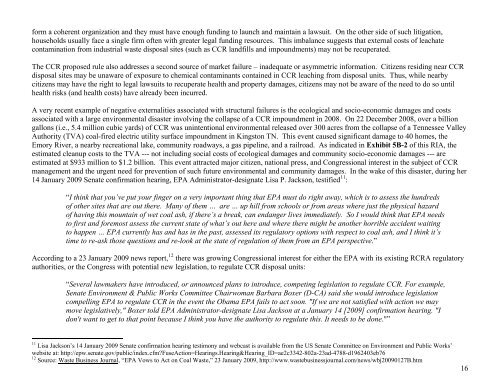Analysis - The Institute for Southern Studies
Analysis - The Institute for Southern Studies
Analysis - The Institute for Southern Studies
You also want an ePaper? Increase the reach of your titles
YUMPU automatically turns print PDFs into web optimized ePapers that Google loves.
<strong>for</strong>m a coherent organization and they must have enough funding to launch and maintain a lawsuit. On the other side of such litigation,<br />
households usually face a single firm often with greater legal funding resources. This imbalance suggests that external costs of leachate<br />
contamination from industrial waste disposal sites (such as CCR landfills and impoundments) may not be recuperated.<br />
<strong>The</strong> CCR proposed rule also addresses a second source of market failure – inadequate or asymmetric in<strong>for</strong>mation. Citizens residing near CCR<br />
disposal sites may be unaware of exposure to chemical contaminants contained in CCR leaching from disposal units. Thus, while nearby<br />
citizens may have the right to legal lawsuits to recuperate health and property damages, citizens may not be aware of the need to do so until<br />
health risks (and health costs) have already been incurred.<br />
A very recent example of negative externalities associated with structural failures is the ecological and socio-economic damages and costs<br />
associated with a large environmental disaster involving the collapse of a CCR impoundment in 2008. On 22 December 2008, over a billion<br />
gallons (i.e., 5.4 million cubic yards) of CCR was unintentional environmental released over 300 acres from the collapse of a Tennessee Valley<br />
Authority (TVA) coal-fired electric utility surface impoundment in Kingston TN. This event caused significant damage to 40 homes, the<br />
Emory River, a nearby recreational lake, community roadways, a gas pipeline, and a railroad. As indicated in Exhibit 5B-2 of this RIA, the<br />
estimated cleanup costs to the TVA --- not including social costs of ecological damages and community socio-economic damages --- are<br />
estimated at $933 million to $1.2 billion. This event attracted major citizen, national press, and Congressional interest in the subject of CCR<br />
management and the urgent need <strong>for</strong> prevention of such future environmental and community damages. In the wake of this disaster, during her<br />
14 January 2009 Senate confirmation hearing, EPA Administrator-designate Lisa P. Jackson, testified 11 :<br />
“I think that you’ve put your finger on a very important thing that EPA must do right away, which is to assess the hundreds<br />
of other sites that are out there. Many of them … are … up hill from schools or from areas where just the physical hazard<br />
of having this mountain of wet coal ash, if there’s a break, can endanger lives immediately. So I would think that EPA needs<br />
to first and <strong>for</strong>emost assess the current state of what’s out here and where there might be another horrible accident waiting<br />
to happen … EPA currently has and has in the past, assessed its regulatory options with respect to coal ash, and I think it’s<br />
time to re-ask those questions and re-look at the state of regulation of them from an EPA perspective.”<br />
According to a 23 January 2009 news report, 12 there was growing Congressional interest <strong>for</strong> either the EPA with its existing RCRA regulatory<br />
authorities, or the Congress with potential new legislation, to regulate CCR disposal units:<br />
“Several lawmakers have introduced, or announced plans to introduce, competing legislation to regulate CCR. For example,<br />
Senate Environment & Public Works Committee Chairwoman Barbara Boxer (D-CA) said she would introduce legislation<br />
compelling EPA to regulate CCR in the event the Obama EPA fails to act soon. "If we are not satisfied with action we may<br />
move legislatively," Boxer told EPA Administrator-designate Lisa Jackson at a January 14 [2009] confirmation hearing. "I<br />
don't want to get to that point because I think you have the authority to regulate this. It needs to be done."”<br />
11 Lisa Jackson’s 14 January 2009 Senate confirmation hearing testimony and webcast is available from the US Senate Committee on Environment and Public Works’<br />
website at: http://epw.senate.gov/public/index.cfm?FuseAction=Hearings.Hearing&Hearing_ID=ae2c3342-802a-23ad-4788-d1962403eb76<br />
12 Source: Waste Business Journal, “EPA Vows to Act on Coal Waste,” 23 January 2009, http://www.wastebusinessjournal.com/news/wbj20090127B.htm<br />
16




